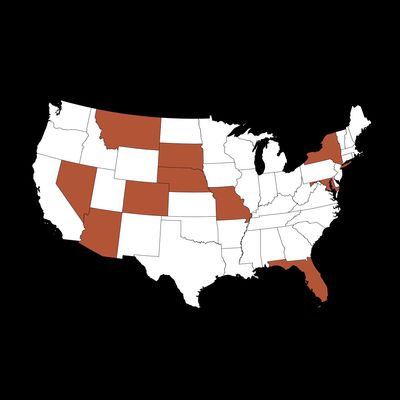
Abortion ballot measures’ undefeated streak at the polls post-Dobbs ended on Tuesday night. There were abortion-related referendums on the ballot in ten states on November 5, the first presidential election since the Supreme Court overturned Roe v. Wade. While some states passed protections for abortion care — some of them while simultaneously electing Donald Trump, who has tried to get as much distance as he can from the issue given the direct role he played in the end of Roe — three measures failed to hit the necessary threshold to restore abortion rights. So what did voters decide? Keep reading to find out how each ballot measure performed.
Arizona’s Proposition 139
Proposition 139 passed with around 61 percent of the vote. The measure will codify “the fundamental right to abortion” in the state constitution up until viability, or around 24 weeks of pregnancy. That paves the way for Arizona’s current 15-week abortion ban, which only makes an exception to save the pregnant person’s life, to be overturned. The amendment comes just months after a civil-rights-era near-total abortion ban was upheld by the state Supreme Court before lawmakers quickly repealed it.
Colorado’s Amendment 79
Coloradans voted to pass Amendment 79. Although there are virtually no restrictions in the state, Amendment 79 will formally codify abortion rights in the Colorado constitution and repeal a 1984 law that prohibits using public health-insurance plans to pay for abortion care.
Florida’s Amendment 4
Amendment 4 had the highest threshold to meet among all ballot measures in this election at 60 percent, and despite winning a majority of votes — even more votes than Governor Ron DeSantis earned during his 2022 reelection campaign! — it fell short of passing. That means Florida’s current six-week ban, which prohibits abortion care before most people know they are pregnant, will remain in place for now.
Back in September, I spent a weekend shadowing pro-choice canvassers in Florida’s bellwether Pinellas County. The Yes on 4 campaign had a steep hill to climb to convince 60 percent of voters to support the referendum as many voters didn’t even know the amendment was on the ballot. The DeSantis administration also devoted considerable state and legal resources to defeating it.
Maryland’s Question 1
As expected, Maryland voted decisively to protect abortion rights, approving Question 1. The state currently allows abortions up until viability, and the measure will codify the right “to make and effectuate decisions to prevent, continue, or end one’s own pregnancy” in the state constitution.
Missouri’s Amendment 3
Missouri passed Amendment 3, paving the way to becoming the first state to reverse a near-total post-Dobbs abortion ban. The measure will codify the right to “reproductive freedom” in the state’s constitution, allowing for abortion care up until viability once again. Back in 2022, Missouri was the first state to ban abortion care, doing so within minutes of the Supreme Court issuing its Dobbs decision; the law makes an exception only for cases of limited medical emergencies.
“This amendment is not earth-shattering. It is really just putting health care back where it belongs,” Dr. Jennifer Smith, an OB/GYN in St. Louis who campaigned for the measure, told me in September. “In every other aspect of health care, we have these conversations with patients and make these decisions without government interference. All we’re asking is to have women in our state have that same basic freedom.”
Montana’s CI-128
CI-128 was approved with more than 57 percent of the vote. Abortion is legal in Montana through viability, and the measure will codify the right to “make and carry out decisions about one’s own pregnancy, including the right to abortion” in the state constitution.
Nebraska’s Initiative 439
Nebraska voters failed to pass Initiative 439, a pro-choice measure that would have established the right to abortion until fetal viability. Instead, they approved Initiative 434, an anti-abortion amendment that will codify the state’s current 12-week ban into its constitution. In order to overturn Initiative 434 in the future, Nebraskans will need to organize another citizen-initiated petition campaign, or else have 60 percent of the GOP-controlled state legislature vote to overturn it before sending a measure to voters for approval.
Nevada’s Question 6
About 63 percent of Nevadans approved Question 6, which would codify the right to abortion up until viability, or about 24 weeks of pregnancy. The measure won’t go into effect immediately, however. Voters will have to approve it once again in the 2026 election before language enshrining abortion rights can be added to the state constitution.
New York’s Proposal 1
New York passed Proposal 1 with about 61 percent of the vote. The state currently allows abortions until viability; Proposal 1 will codify this status quo in the state constitution, in addition to adding protections for “pregnancy, pregnancy outcomes, and reproductive health care and autonomy.”
South Dakota’s Amendment G
Amendment G only obtained support from about 40 percent of voters in South Dakota, falling short of passage. The measure would have overturned the state’s near-total ban by codifying the right to abortion in the first trimester. It also would have allowed the government to regulate care in the second and third trimesters.
The Cut offers an online tool you can use to search by Zip Code for professional providers, including clinics, hospitals, and independent OB/GYNs, as well as for abortion funds, transportation options, and information for remote resources like receiving the abortion pill by mail. For legal guidance, contact Repro Legal Helpline at 844-868-2812 or the Abortion Defense Network.


